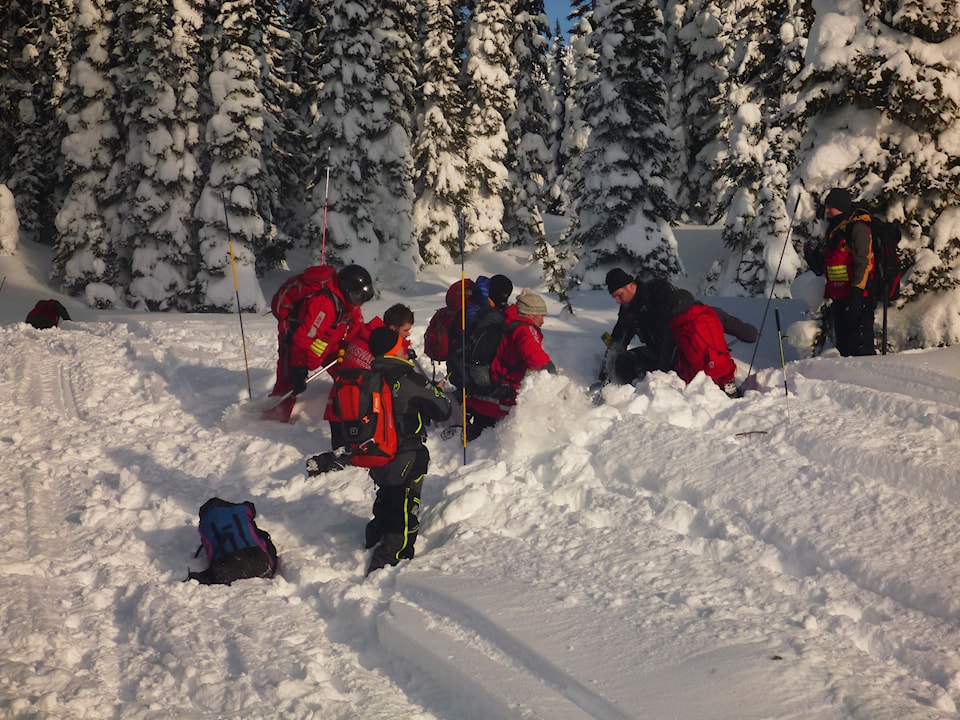A changing culture in the snowmobile world may be the reason Shuswap Volunteer Search and Rescue (SVSAR) members are getting fewer calls to find missing sledders this year.
”Winters are our leading call-outs by category; that being said call volumes are down a bit,” says SVSAR president Luke Gubbels. “People are self-rescuing a bit more and people who are getting stuck are more likely to come up with a plan to get themselves out.”
Gubbels says in 2016, SVSAR members put in more than 9,000 volunteer hours in what proved to be the group’s busiest year on record.
Training and preparedness remain a top priority for the 40 SVSAR volunteers who are willing to go out at any time and in all kinds of weather to help others.
In order to do this, all SVSAR members who want to be involved in winter operations, have to take a two-day, Level 1 basic Avalanche Skills Training course. It is a course Avalanche Canada recommends for anyone who is planning to venture out into the backcountry.
Taught by a qualified instructor, the course is given at Owlhead on a weekend from 8 a.m. to 5 p.m. each day and is prefaced by a four-hour classroom session the week prior to the hands-on course.
Four members of SVSAR are also trained to the (Canadian Avalanche Association) CAA Level 2, having taken a week-long course of 10-hour days with an experienced and qualified instructor.
”When we get a call, part of the operational guidelines is we have to have two level ones and we have to be in contact with a level two when initiating our rescue,” Gubbels says, explaining that snow changes overnight and sledders often don’t listen to avalanche warnings until the risks go beyond ‘considerable’ to ‘high’ or ‘extreme.’ “We get in touch with a Level two who is working in the field and they give us information on the snowpack; they ask where we’re going and give us a pretty good rundown on that area.”
Gubbels says that information is passed on to search managers for discussion and a decision as to whether or not responding to a call puts volunteers into a dangerous avalanche situation.
“We often have to go out at night and we can’t assess the situation,” he says. “We’re more than willing to respond to a genuine emergency if someone is lost or might have to spend the night on the mountain, rather than the guy who just doesn’t want to leave his sled behind.”
For the most part, Gubbels says sledders are better prepared, more familiar with where they’re going, more avalanche-aware and armed with better communication and emergency plans.
On Owlhead, Gubbels offers particular praise to Gord Bushell, manager of the Eagle Valley Snowmobile Club, who has done an excellent job at sharing educational information at meetings, posting signs and talking to people in the parking lots, something RCMP officers sometimes do as well.
“You should have a plan, assign a leader for the day and make sure you get down at the appointed time,” Gubbels says. “And make sure you have what you need to spend the night – the ability to start a fire, emergency blankets and shelter, warm clothing and food and water.”
Except for a pair of pants and a jacket, search and rescue volunteers pay for all their basic gear and devote long hours to learning and practising critical skills.
“SVSAR is a society in constant motion either on task, training, educating, fundraising, learning and preparing to serve our community to the best of our ability,” he says. “We thank the numerous community groups, the Columbia Shuswap Regional District, Province of BC and the members of the public for their continued support. We exist to help those in need because of your generosity.”
